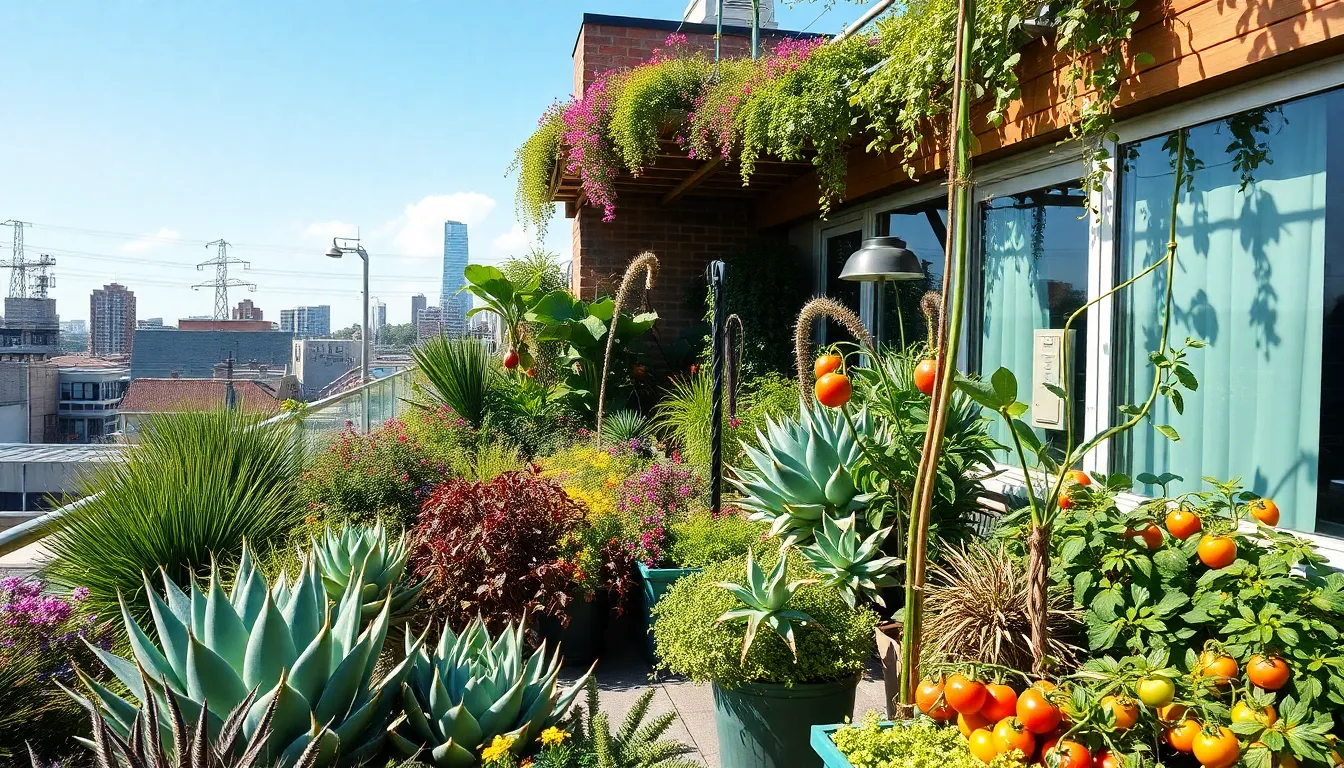Imagine stepping onto your rooftop and finding a lush oasis instead of the usual concrete jungle. Rooftop gardens are the ultimate green escape, transforming dull spaces into vibrant retreats. Not only do they add beauty, but they also provide a bounty of benefits—from reducing energy costs to improving air quality. Who knew that growing tomatoes could also help cool your apartment?
Table of Contents
ToggleOverview of Rooftop Gardens
Rooftop gardens transform rooftops into green spaces. These gardens provide aesthetic enhancement and numerous functional benefits.
Definition and Concept
Rooftop gardens refer to vegetation planted on the roofs of buildings. This concept integrates landscaping with urban architecture. They can vary in size and complexity, ranging from small herb gardens to extensive recreational areas. Absorbing rainwater, they reduce runoff while offering insulation during colder months. Many also incorporate sustainable practices, promoting biodiversity in urban environments.
Benefits of Rooftop Gardens
Rooftop gardens contribute significantly to energy efficiency. By insulating buildings, they lower heating and cooling costs. Improved air quality results from the plants absorbing CO2 and releasing oxygen. Additionally, these gardens mitigate urban heat effects, keeping cities cooler. They also provide spaces for food production, enabling the cultivation of tomatoes and other vegetables. Moreover, rooftop gardens enhance property value, making buildings more attractive to potential tenants and buyers.
Types of Rooftop Gardens

Rooftop gardens come in various designs and plant selections, each offering unique benefits. Understanding their types helps in planning an effective green space.
Extensive vs. Intensive Gardens
Extensive gardens feature lighter soil substrates, typically ranging from 2 to 6 inches in depth. They focus on low-maintenance vegetation such as sedums and grasses. This type typically requires less irrigation and maintenance. Intensive gardens, however, use deeper soil layers, often exceeding 6 inches. Such gardens support a wider variety of plants, including shrubs and small trees. Intensive setups often require more frequent watering and upkeep, offering diverse options for gardeners seeking to grow vegetables or flowers.
Types of Plant Selection
Succulents and drought-resistant species thrive in extensive gardens. Hardy varieties often include native grasses and herbs. In contrast, intensive gardens allow for a broader range of plant selection. These gardens accommodate fruiting plants like tomatoes, peppers, and leafy greens. Flowering plants, including perennials and annuals, can also enhance aesthetic appeal. Selecting appropriate plants ensures that gardens not only flourish but also meet specific goals, such as food production or ornamental value.
Design and Installation
Design and installation of rooftop gardens involve careful planning and the incorporation of essential features.
Planning Considerations
Consider the structural capacity of the building when planning a rooftop garden. Assessing load-bearing limits ensures the roof can support the weight of soil and plants. It’s vital to evaluate sunlight and wind exposure, as these factors influence plant selection and garden layout. Additionally, drainage systems require attention to prevent water accumulation. Infrastructure for irrigation simplifies garden maintenance and enhances plant health. Identify the primary purpose of the garden, whether for aesthetics, food production, or recreation, to tailor the design to specific needs.
Essential Features for Rooftop Gardens
Selecting appropriate soil plays a crucial role in rooftop garden success. Lightweight soil mixes reduce weight stress while providing proper drainage and nourishment. Proper irrigation systems, such as drip systems or rainwater collection methods, ensure water efficiency. Plant selection varies based on sunlight and desired aesthetics; native species often thrive better and require less maintenance. Incorporating seating areas offers spaces for relaxation and enjoyment. Windbreaks, like trellises or fencing, enhance comfort by minimizing wind exposure. Lastly, utilizing raised beds can improve accessibility and enhance the visual appeal of the garden.
Maintenance and Sustainability
Rooftop gardens require focused maintenance efforts to ensure their longevity and environmental benefits. Sustainable practices contribute significantly to their overall health.
Watering and Irrigation Systems
Efficient watering systems play a crucial role in rooftop garden maintenance. Drip irrigation systems deliver water directly to the plant roots, minimizing evaporation and runoff. By using timers or moisture sensors, gardeners can automate the watering schedule based on weather conditions. Rainwater harvesting systems can collect and store rainwater, providing a valuable resource for irrigation. Regular monitoring of soil moisture levels ensures plants receive adequate hydration without overwatering.
Pest Management Strategies
Effective pest management minimizes the need for chemical interventions. Natural predators, such as ladybugs and lacewings, contribute to maintaining balanced ecosystems within rooftop gardens. Companion planting promotes biodiversity and can deter unwanted insects. Additionally, organic insecticidal soaps offer an eco-friendly option for addressing pest issues when necessary. Regular inspections help identify early signs of infestations, making timely interventions possible.
Rooftop gardens offer an innovative solution for urban living by creating vibrant green spaces that enhance both aesthetics and functionality. They not only provide a sanctuary for relaxation but also contribute to environmental sustainability through improved air quality and reduced energy costs. The careful selection of plants and thoughtful design can transform rooftops into thriving ecosystems.
With proper planning and maintenance, these gardens can flourish, providing food and beauty while promoting biodiversity. As cities continue to expand, embracing rooftop gardens becomes increasingly essential for a healthier urban environment. Investing in these green spaces not only elevates property value but also fosters a sense of community and connection to nature amidst the concrete landscape.


